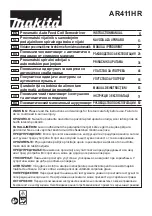
5 ENGLISH
ENGLISH (Original instructions)
SPECIFICATIONS
Model:
AR411HR
Air pressure
1.76 - 2.26 MPa (17.6 - 22.6 bar)
Screw length
25 - 41 mm
Screw diameter
For steel sheet backing
3.5 mm
For wood backing
3.8 mm
Screw capacity
Coil tape collated screws 100 pcs
Safety device
Contact arm system
Drive adjustment
Dial type (adjustment range: 6 mm)
Screw feed mechanism
Feed piston system
Minimum hose diameter
5.0 mm
Pneumatic tool oil
ISO VG32 or equivalent
Dimensions (L x W x H) (with hook)
276 mm x 120 mm x 316 mm
Net weight
2.0 kg
•
Due to our continuing program of research and development, the specifications herein are subject to change
without notice.
•
Specifications may differ from country to country.
Symbols
The following show the symbols used for the equip
-
ment. Be sure that you understand their meaning before
use.
Read instruction manual.
Wear safety glasses.
Wear ear protection.
The tool has the capability of operating in
contact actuation mode.
Do not use on scaffoldings, ladders.
Intended use
The tool is intended for fixing plaster boards.
The tool is for high-volume professional application
only. Do not use it for any other purpose. It is not
designed to drive fasteners directly on a hard surface
like steel and concrete.
Noise
The typical A-weighted noise level determined accord
-
ing to EN ISO 11148-13:
Sound pressure level (L
pA
) : 78 dB(A)
Uncertainty (K) : 3 dB(A)
The noise level under working may exceed 80 dB (A).
WARNING:
Wear ear protection.
Vibration
The vibration total value determined according to EN
ISO 11148-13:
Vibration emission (a
h
) : 2.5 m/s
2
or less
Uncertainty (K) : 1.5 m/s
2
NOTE:
The declared vibration total value(s) has been
measured in accordance with a standard test method
and may be used for comparing one tool with another.
NOTE:
The declared vibration total value(s) may also
be used in a preliminary assessment of exposure.
WARNING:
The vibration emission during
actual use of the power tool can differ from the
declared value(s) depending on the ways in which
the tool is used especially what kind of workpiece
is processed.
WARNING:
Be sure to identify safety mea-
sures to protect the operator that are based on an
estimation of exposure in the actual conditions of
use (taking account of all parts of the operating
cycle such as the times when the tool is switched
off and when it is running idle in addition to the
trigger time).






































